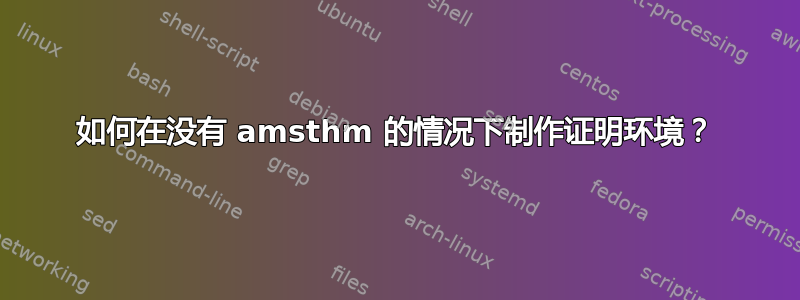
该课程使用一个名为“定理”的包,并且他们编写了自己的定理命令
\theorembodyfont{\itshape}
\theoremheaderfont{\scshape}
\setlength{\theorempreskipamount}{6pt plus 2pt}
\setlength{\theorempostskipamount}{6pt plus 2pt}
\begingroup \makeatletter
\gdef\th@plain{\normalfont\itshape
\def\@begintheorem##1##2{%
\item[\hskip\labelsep \theorem@headerfont ##1\ {##2.}]}%
\def\@opargbegintheorem##1##2##3{%
\item[\hskip\labelsep \theorem@headerfont ##1\ ##2\ (##3)]}}
\endgroup
因此,我不能包含包 amsthm,因为我会收到错误
! LaTeX Error: Command \theoremstyle already defined.
但是,如果不包含 amsthm 包,我就无法使用 proof 环境。我向期刊询问了他们的建议,他们回答说我可以使用
\newcommand{\proof}{\noindent {\it Proof. }}
但是如果不使用 amsthm,我怎样才能得到证明结束时的平方呢?
答案1
从中复制一些定义amsthm.sty:
\documentclass{article}
%% from here-------------------------
\makeatletter
\DeclareRobustCommand{\qed}{%
\ifmmode % if math mode, assume display: omit penalty etc.
\else \leavevmode\unskip\penalty9999 \hbox{}\nobreak\hfill
\fi
\quad\hbox{\qedsymbol}}
\newcommand{\openbox}{\leavevmode
\hbox to.77778em{%
\hfil\vrule
\vbox to.675em{\hrule width.6em\vfil\hrule}%
\vrule\hfil}}
\newcommand{\qedsymbol}{\openbox}
\newenvironment{proof}[1][\proofname]{\par
\normalfont
\topsep6\p@\@plus6\p@ \trivlist
\item[\hskip\labelsep\itshape
#1.]\ignorespaces
}{%
\qed\endtrivlist
}
\newcommand{\proofname}{Proof}
\makeatother
%% upto here----------------------------
\begin{document}
\begin{proof}
This is a proof
\end{proof}
\end{document}

答案2
一种甚至更短的方法,再次窃取(或改编)了的定义amsthm.sty。
\providecommand{\qedsymbol}{$\square$}
\newcommand{\mathqed}{\quad\hbox{\qedsymbol}}
\DeclareRobustCommand{\qed}{%
\ifmmode \mathqed
\else
\leavevmode\unskip\penalty9999 \hbox{}\nobreak\hfill
\quad\hbox{\qedsymbol}%
\fi
}
然后,如果你真的不想定义proof环境,你可以简单地使用
\proof期刊工作人员建议的命令(但请使用{\itshape ...}或
\textit{...}代替\it!),并以以下形式结束定理陈述
`\qed`
没有在它前面留一个空行。如果它跟在文本后面,这会将框刷新到右边距;如果它在显示的末尾,则会将它放置在距离数学表达式末尾四分之一的位置。您还应该在证明后面留一些额外的空格,比如说
\medskip。
(对文档类的个人观察 - 它已经严重过时了;文档的日期是 1999 年,甚至没有使用当时的“最佳实践”。我会羞于分发它。)
答案3
快速而肮脏 - 比@HarishKumar 的解决方案短得多,可能不太强大,但也许足够了。
\documentclass{article}
\usepackage{amssymb}
\newenvironment{proof}
{\textit{Proof:} }
{$\square$}
\begin{document}
Theorem: whatever
\begin{proof}
Here's why.
\end{proof}
\end{document}



